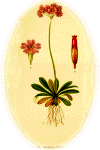


|
Get a GuideMany people are slightly interested in wildflowers and buy a field guide, from the dozen or so available at any given time. Then they expect to be able to look up the flower in front of them and give it a name. It's not quite that easy (usually). If the book covers all the possibilities it will be full of look-a-likes, apparently all the same colour and shape. Then people get discouraged and lose the book. I know - I've been there.So if wildflowers interest you, don't expect to be able to do everything at once. Some flowers even experts cannot name accurately straight away. Some species are very, very similar. If you can look at a flower and get as far as the family to which it belongs, that will sometimes be quite an achievement. In fact identifying the family comes quite quickly once you start looking closely at wildflowers and trying to name them. There are a few large families with representatives in most areas and you will soon recognise their characteristics. Also, very quickly you will get to feel which plants you can expect in a particular habitat. 'By time and place alone a species like cow parsley on roadside verges in May can be named with certainty at 40mph ...' (Franklyn Perring & Max Walters). So do believe it's not that difficult! If I can do it, you can (probably better). So get yourself a good field guide to start with (see Books ). Don't waste money on a huge 'flora' including every plant in the kingdom - it will only confuse you. Get a book with a good, simple key - you don't want to be worrying about prickly achenes too soon! If, like me, you are often reduced to looking through the pictures to find the plant in any case, you will need clear illustrations. Strangely enough photographs, which are very popular nowadays, are not always best at this. Drawings can bring out important details which you will need. See what you think. Also, invest in a book which does not try to cover the whole northern hemisphere in two hundred pages - it can't. You will probably want to build up your own collection of flower books, reflecting your own interests. You might want to look at some which I have found useful and enjoyed - Books. But don't think that you need a library to enjoy wildflowers; you don't. Looking at flowersFirst and foremost, look properly. To identify a plant you have to look for characteristics such as the number of |
petals, how hairy is
it, and so on. Don't think you'll remember important details when you get
back home - write them down. You need to note:
EquipmentProbably the most important piece of equipment is transport. After that, keep it simple. A reasonable hand lens, 10x or 20x, say, will be useful and not expensive. A short metric ruler is surprisingly necessary: some similar species are distinguished most easily by the size of the flower, say. A pin is often useful for getting into the centre of flowers. A notebook is essential; mine doubles as a camera log.Just as essential for me is my camera. You can take photos with a simple camera but to get close to small flowers you will need an SLR - single lens reflex. With this you can see exactly what the camera sees and you can add additional close-up lenses or extension tubes to get a bigger image. RulesOne of the best things about an interest in wildflowers is that it gets you to some wonderful places 'away from it all'. But there are still rules which you must observe to protect the plants. Never uproot a plant; it is illegal to do so without the landowner's permission and some rare ones are specifically protected by law from even being picked or damaged (see Statutory protection).Always ask the landowner's permission before entering on land. If you come across a plant which may be rare, only tell the local Wildlife Trust. Many plants are only rare today because of collectors in the past. Basically, remember that the plant is more important than your own interest. Take it easy, take the book everywhere, take photographs. And if you get chance, do let me know how it's going. |